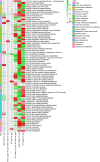Whole-Transcriptome Analysis of Yak and Cattle Heart Tissues Reveals Regulatory Pathways Associated With High-Altitude Adaptation
- PMID: 34093634
- PMCID: PMC8176224
- DOI: 10.3389/fgene.2021.579800
Whole-Transcriptome Analysis of Yak and Cattle Heart Tissues Reveals Regulatory Pathways Associated With High-Altitude Adaptation
Abstract
Background: The yak (Bos grunniens) is an important livestock species that can survive the extremely cold, harsh, and oxygen-poor conditions of the Qinghai-Tibetan Plateau and provide meat, milk, and transportation for the Tibetans living there. However, the regulatory network that drive this hypoxic adaptation remain elusive.
Results: The heart tissues from LeiRoqi (LWQY) yak and their related cattle (Bos Taurus) breeds, which are two native cattle breeds located in high altitude (HAC) and low altitude (LAC) regions, respectively, were collected for RNA sequencing. A total of 178 co-differentially expressed protein-coding transcripts (co-DETs) were discovered in each of the LAC-vs-LWQY and LAC-vs-HAC comparison groups, including NFATC2, NFATC1, ENPP2, ACSL4, BAD, and many other genes whose functions were reported to be associated with the immune-system, endocrine-system, and lipid metabolism. Two and 230 lncRNA transcripts were differentially expressed in the LAC-vs-LWQY and LAC-vs-HAC comparisons' respectively, but no lncRNA transcripts that were co-differentially expressed. Among the 58 miRNAs that were co-differentially expressed, 18 were up-regulated and 40 were down-regulated. In addition, 640 (501 up-regulated and 139 down-regulated) and 152 (152 up-regulated and one down-regulated) circRNAs showed differential expression in LAC-vs-LWQY and LAC-vs-HAC comparison groups, respectively, and 53 up-regulated co-differentially expressed circRNAs were shared. Multiple co-DETs, which are the targets of miRNAs/lncRNAs, are significantly enriched in high-altitude adaptation related processes, such as, T cell receptor signaling, VEGF signaling, and cAMP signaling. A competing endogenous RNA (ceRNA) network was constructed by integrating the competing relationships among co-differentially expressed mRNAs, miRNAs, lncRNAs and circRNAs. Furthermore, the hypoxic adaptation related ceRNA network was constructed, and the six mRNAs (MAPKAPK3, PXN, NFATC2, ATP7A, DIAPH1, and F2R), the eight miRNAs (including miR-195), and 15 circRNAs (including novel-circ-017096 and novel-circ-018073) are proposed as novel and promising candidates for regulation of hypoxic adaptation in the heart.
Conclusion: In conclusion, the data recorded in the present study provides new insights into the molecular network of high-altitude adaptation along with more detailed information of protein-coding transcripts and non-coding transcripts involved in this physiological process, the detailed mechanisms behind how these transcripts "crosstalk" with each other during the plateau adaptation are worthy of future research efforts.
Keywords: cattle; ceRNA network; co-differentially expressed transcripts; hypoxic adaptation; whole-transcriptome; yak.
Copyright © 2021 Wang, Zhong, Wang, Chai, Zhang, Xin, Wang, Cai, Wu and Ji.
Conflict of interest statement
The authors declare that the research was conducted in the absence of any commercial or financial relationships that could be construed as a potential conflict of interest.
Figures






References
-
- Ahmad K. S., Hameed M., Fatima S., Ashraf M., Ahmad F., Naseer M., et al. (2016). Morpho-anatomical and physiological adaptations to high altitude in some Aveneae grasses from Neelum Valley. Western Himalayan Kashmir Acta Physiol. Plant. 38:93.
LinkOut - more resources
Full Text Sources
Research Materials
Miscellaneous

